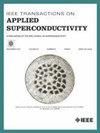Assessment of Hysteresis Losses in HTS Coils Designed for a Rotating Electrical Machine
IF 1.8
3区 物理与天体物理
Q3 ENGINEERING, ELECTRICAL & ELECTRONIC
引用次数: 0
Abstract
The development of superconducting machines has long been pursued due to their relevant power density advantages and high efficiency compared to conventional technologies. However, using superconductors under alternating current and/or magnetic field poses considerable challenges as they demonstrate non-negligible energy dissipation from the generated ac losses. This work investigates the electrical behavior of a high-temperature superconducting (HTS) coil designed for rotating electrical machines. Both experimental activities and simulation studies are conducted with the primary aim of estimating the ac transport current losses. Accordingly, a circular-shaped coil in a double-pancake configuration is assembled using GdBCO tape (12 mm × 0.15 mm) manufactured by SuNAM Co. Ltd.; it is subsequently tested under dc and ac conditions at cryogenic temperature. Simultaneously, numerical simulations are performed using the commercial software Comsol Multiphysics. Considering the anisotropic field dependence of the critical current density旋转电机用高温超导线圈的磁滞损耗评估
与传统技术相比,超导机械由于具有相关的功率密度优势和高效率,一直受到人们的关注。然而,在交流电流和/或磁场下使用超导体带来了相当大的挑战,因为它们从产生的交流损耗中表现出不可忽略的能量耗散。本文研究了用于旋转电机的高温超导线圈的电学特性。实验活动和模拟研究的主要目的是估计交流输运电流损失。因此,使用SuNAM公司生产的GdBCO胶带(12 mm × 0.15 mm)组装成双煎饼结构的圆形线圈;随后在直流和交流条件下在低温下进行测试。同时,利用商业软件Comsol Multiphysics进行了数值模拟。考虑临界电流密度Jc(B)的各向异性场依赖性,建立了基于h公式的二维轴对称模型。研究了不同的应用频率和峰值电流条件,以优化超导电机电枢组装用高温超导线圈的设计。最后,通过与实验数据的比较,验证了数值计算结果的正确性。
本文章由计算机程序翻译,如有差异,请以英文原文为准。
求助全文
约1分钟内获得全文
求助全文
来源期刊

IEEE Transactions on Applied Superconductivity
工程技术-工程:电子与电气
CiteScore
3.50
自引率
33.30%
发文量
650
审稿时长
2.3 months
期刊介绍:
IEEE Transactions on Applied Superconductivity (TAS) contains articles on the applications of superconductivity and other relevant technology. Electronic applications include analog and digital circuits employing thin films and active devices such as Josephson junctions. Large scale applications include magnets for power applications such as motors and generators, for magnetic resonance, for accelerators, and cable applications such as power transmission.
 求助内容:
求助内容: 应助结果提醒方式:
应助结果提醒方式:


